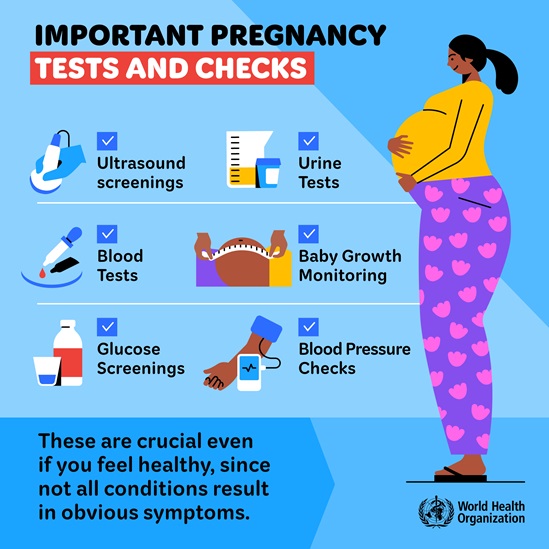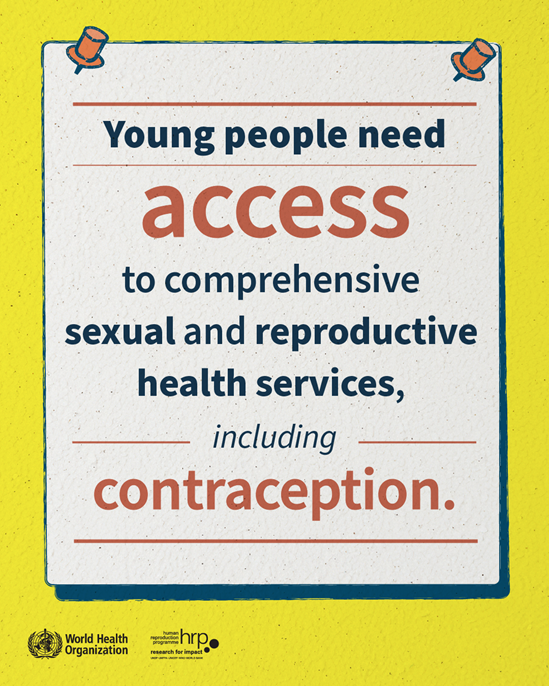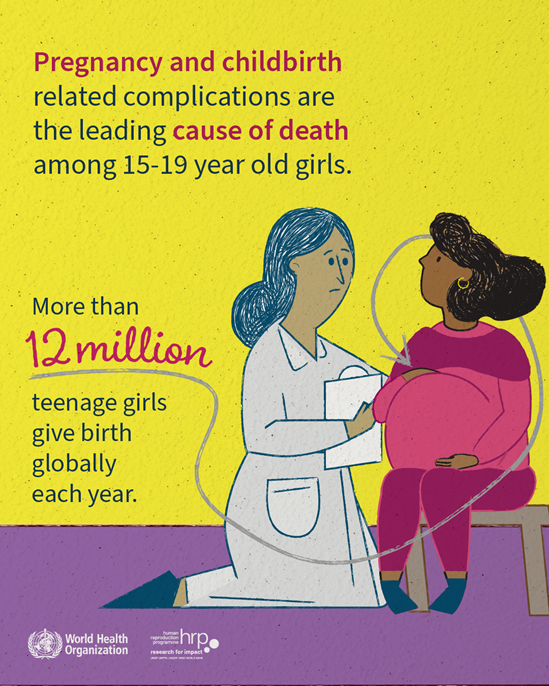2024
(Supp) Improving the lives of adolescents and young adults, Journal of Adolescent Health. October 2024, Vol 75, Issue 4, p525-690.
Chalasani S, Rumble L, Banati P, Bastien S, Luna JR, Petroni S. Adolescents and the International Conference on Population and Development at 30. Lancet Child Adolesc Health. Published online September 11, 2024. doi:10.1016/S2352-4642(24)00235-9
Lassi ZS, Rahim KA, Stavropoulos AM, et al. Use of contraceptives, empowerment and agency of adolescent girls and young women: a systematic review and meta-analysis. BMJ Sex Reprod Health. 2024;50(3):195-211. Published 2024 Jul 12. doi:10.1136/bmjsrh-2023-202151
Javadi D, Sacks E, Brizuela V, et al. Factors that influence the uptake of postnatal care among adolescent girls: a qualitative evidence synthesis. BMJ Glob Health. 2023;8(Suppl 2):e011560. doi:10.1136/bmjgh-2022-011560
Barua A, Chandra-Mouli V, Mehta R, et al. Lessons learned from conceptualising and operationalising the National Adolescent Health Programme or Rashtriya Kishor Swasthya Karyakram's Learning Districts Initiative in six districts of India. Sex Reprod Health Matters. 2023;31(1):2283983. doi:10.1080/26410397.2023.2283983
2023
Plesons M, De Meyer S, Amo-Adjei J, et al. Protocol for a multi-country implementation research study to assess the feasibility, acceptability, and effectiveness of context-specific actions to train and support facilitators to deliver sexuality education to young people in out-of-school settings. Sex Reprod Health Matters. 2023;31(2):2204043. doi:10.1080/26410397.2023.2204043
Gonsalves L, Kamuyango A, Chandra-Mouli V. Pharmacies: an important source of contraception for some adolescents, but not a panacea for all. Sex Reprod Health Matters. 2023;31(1):2221883. doi:10.1080/26410397.2023.2221883
Maceira D, Oizerovich S, Perrotta G, et al. Acceptability and continuation of use of the subdermal contraceptive implant among adolescents and young women in Argentina: a retrospective cohort study. Sex Reprod Health Matters. 2023;31(1):2189507. doi:10.1080/26410397.2023.2189507
Ramaiya A, Chandra-Mouli V, Both R, et al. Assessing the health, social, educational and economic impact of the COVID-19 pandemic on adolescents in low- and middle-income countries: a rapid review of the literature. Sex Reprod Health Matters. 2023;31(1):2187170. doi:10.1080/26410397.2023.2187170
2022
Adebayo E, Essiet A, Plesons M, et al. "Commitment, Concessions and Compromise. Experiences of building support for and addressing resistance to sexuality education from Nigeria" Open Health, vol. 3, no. 1, 2022, pp. 155-167. https://doi.org/10.1515/openhe-2022-0027
Akwara E, Worknesh K, Oljira L, et al. ASRHR in Ethiopia: reviewing progress over the last 20 years and looking ahead to the next 10 years [published correction appears in Reprod Health. 2022 Aug 4;19(1):173. doi: 10.1186/s12978-022-01474-y]. Reprod Health. 2022;19(Suppl 1):123. Published 2022 Jun 13. doi:10.1186/s12978-022-01434-6
Sardinha L, García-Moreno C, Guthold R. Global Estimated Prevalence of Physical and/or Sexual Intimate Partner Violence Against Ever-Partnered Women, by Age, 2018. J Adolesc Health. 2022;70(6):846-847. doi:10.1016/j.jadohealth.2021.12.019
Bastien S, Ferenchick E, Mbassi SM, Plesons M, Chandra-Mouli V. Improving health worker motivation and performance to deliver adolescent sexual and reproductive health services in the Democratic Republic of Congo: study design of implementation research to assess the feasibility, acceptability, and effectiveness of a package of interventions. Glob Health Action. 2022;15(1):2022280. doi:10.1080/16549716.2021.2022280
2021
Muthengi E, Olum R, Chandra-Mouli V. Context Matters-One Size Does Not Fit All When Designing Interventions to Prevent Child Marriage. J Adolesc Health. 2021;69(6S):S1-S3. doi:10.1016/j.jadohealth.2021.09.018
Odimba SO, Squires F, Ferenchick E, et al. A collaborative learning approach to improving health worker performance in adolescent sexual and reproductive health service provision: a descriptive feasibility study in six health zones in the Democratic Republic of the Congo. Glob Health Action. 2021;14(1):1985228. doi:10.1080/16549716.2021.1985228
Guthold R, Carvajal-Velez L, Adebayo E, et al. The Importance of Mental Health Measurement to Improve Global Adolescent Health. J Adolesc Health. 2023;72(1S):S3-S6. doi:10.1016/j.jadohealth.2021.03.030
Plesons M, Travers E, Malhotra A, et al. Updated research gaps on ending child marriage and supporting married girls for 2020-2030. Reprod Health. 2021;18(1):152. Published 2021 Jul 20. doi:10.1186/s12978-021-01176-x
Newby H, Marsh AD, Moller AB, et al. A Scoping Review of Adolescent Health Indicators. J Adolesc Health. 2021;69(3):365-374. doi:10.1016/j.jadohealth.2021.04.026
Chandra-Mouli V, Plesons M. A Groundbreaking Systematic Review, but That Alone Is Not Enough to Change the Course of Programming on Child Marriage Prevention. J Adolesc Health. 2021;68(5):833-835. doi:10.1016/j.jadohealth.2021.02.016
Chandra-Mouli V, Neal S, Moller AB. Adolescent sexual and reproductive health for all in sub-Saharan Africa: a spotlight on inequalities. Reprod Health. 2021;18(Suppl 1):118. Published 2021 Jun 17. doi:10.1186/s12978-021-01145-4
Igras S, Plesons M, Chandra-Mouli V. Building evidence on what works (and what does not): practical guidance from the World Health Organization on post-project evaluation of adolescent sexual and reproductive health projects. Health Policy Plan. 2021;36(5):594-605. doi:10.1093/heapol/czab028
Hennegan J, Winkler IT, Bobel C, et al. Menstrual health: a definition for policy, practice, and research. Sex Reprod Health Matters. 2021;29(1):1911618. doi:10.1080/26410397.2021.1911618
Vanderkruik R, Gonsalves L, Kapustianyk G, Allen T, Say L. Mental health of adolescents associated with sexual and reproductive outcomes: a systematic review. Bull World Health Organ. 2021;99(5):359-373K. doi:10.2471/BLT.20.254144
Plesons M, Patkar A, Babb J, et al. The state of adolescent menstrual health in low- and middle-income countries and suggestions for future action and research. Reprod Health. 2021;18(1):31. Published 2021 Feb 8. doi:10.1186/s12978-021-01082-2
Mwaisaka J, Gonsalves L, Thiongo M, et al. Young People's Experiences Using an On-Demand Mobile Health Sexual and Reproductive Health Text Message Intervention in Kenya: Qualitative Study. JMIR Mhealth Uhealth. 2021;9(1):e19109. Published 2021 Jan 15. doi:10.2196/19109
2020
Plesons M, Khanna A, Ziauddin M, Gogoi A, Chandra-Mouli V. Building an enabling environment and responding to resistance to sexuality education programmes: experience from Jharkhand, India. Reprod Health. 2020;17(1):168. Published 2020 Oct 30. doi:10.1186/s12978-020-01003-9
Bash-Taqi R, Watson K, Akwara E, Adebayo E, Chandra-Mouli V. From commitment to implementation: lessons learnt from the first National Strategy for the Reduction of Teenage Pregnancy in Sierra Leone. Sex Reprod Health Matters. 2020;28(1):1818376. doi:10.1080/26410397.2020.1818376
Neal S, Channon AA, Chandra-Mouli V, Madise N. Trends in adolescent first births in sub-Saharan Africa: a tale of increasing inequity?. Int J Equity Health. 2020;19(1):151. Published 2020 Sep 4. doi:10.1186/s12939-020-01251-y
Guerrero F, Lucar N, Garvich Claux M, et al. Developing an SMS text message intervention on sexual and reproductive health with adolescents and youth in Peru. Reprod Health. 2020;17(1):116. Published 2020 Jul 31. doi:10.1186/s12978-020-00943-6
Chandra-Mouli V, Akwara E. Improving access to and use of contraception by adolescents: What progress has been made, what lessons have been learnt, and what are the implications for action?. Best Pract Res Clin Obstet Gynaecol. 2020;66:107-118. doi:10.1016/j.bpobgyn.2020.04.003
Barua A, Watson K, Plesons M, Chandra-Mouli V, Sharma K. Adolescent health programming in India: a rapid review. Reprod Health. 2020;17(1):87. Published 2020 Jun 3. doi:10.1186/s12978-020-00929-4
Gonsalves L, Wyss K, Gichangi P, Hilber AM. Pharmacists as youth-friendly service providers: documenting condom and emergency contraception dispensing in Kenya. Int J Public Health. 2020;65(4):487-496. doi:10.1007/s00038-020-01348-9
Desrosiers A, Betancourt T, Kergoat Y, Servilli C, Say L, Kobeissi L. A systematic review of sexual and reproductive health interventions for young people in humanitarian and lower-and-middle-income country settings. BMC Public Health. 2020;20(1):666. Published 2020 May 12. doi:10.1186/s12889-020-08818-y
Chandra-Mouli V, Akwara E, Engel D, et al. Progress in adolescent sexual and reproductive health and rights globally between 1990 and 2016: what progress has been made, what contributed to this, and what are the implications for the future?. Sex Reprod Health Matters. 2020;28(1):1741495. doi:10.1080/26410397.2020.1741495






